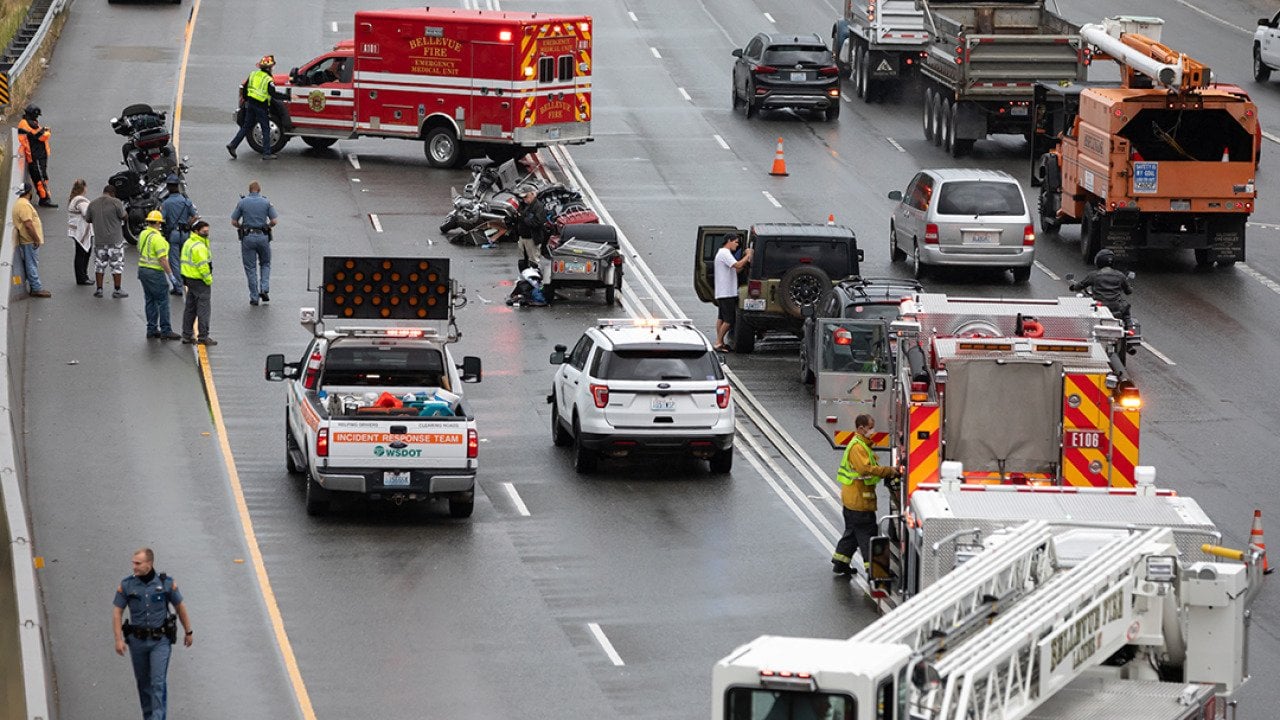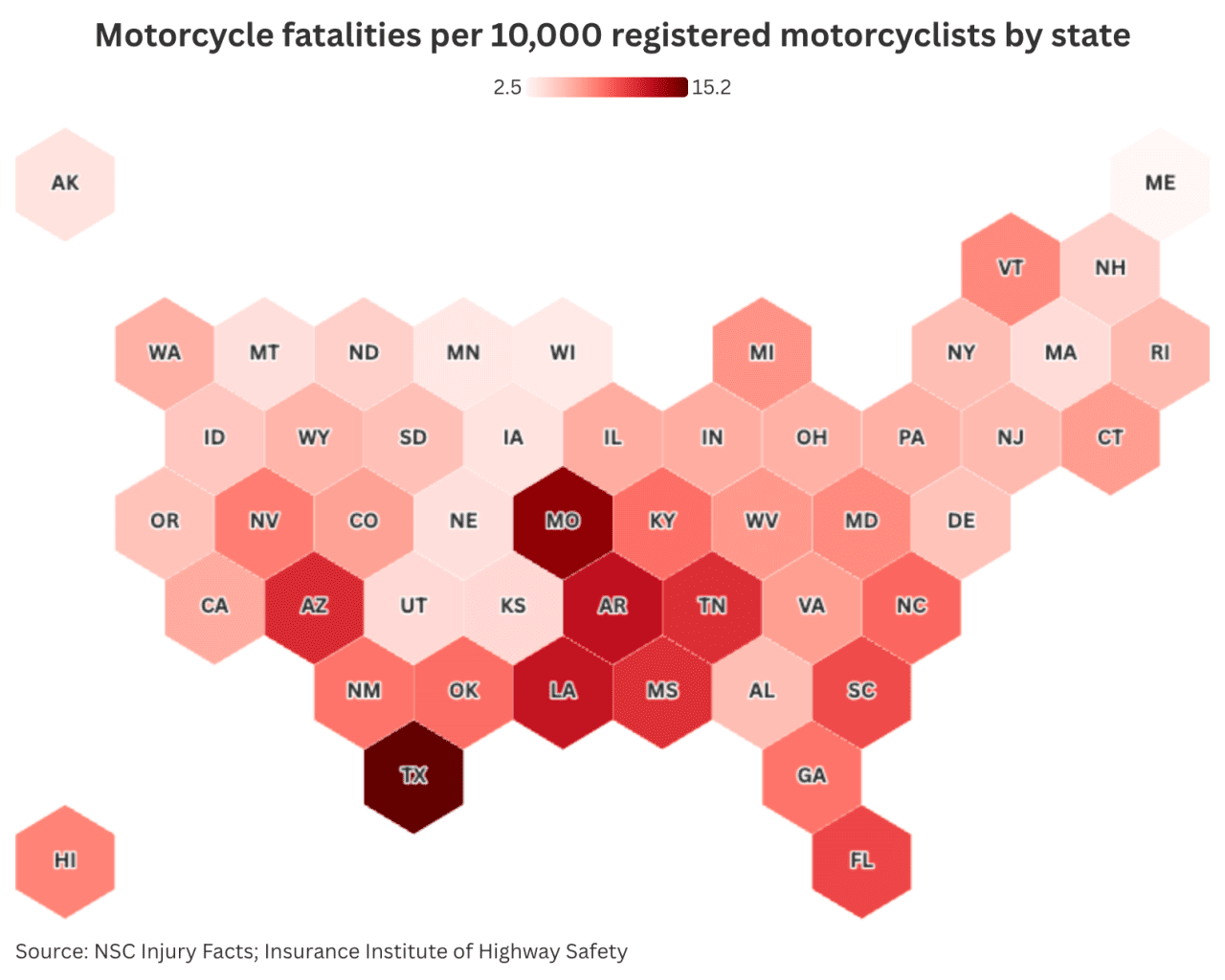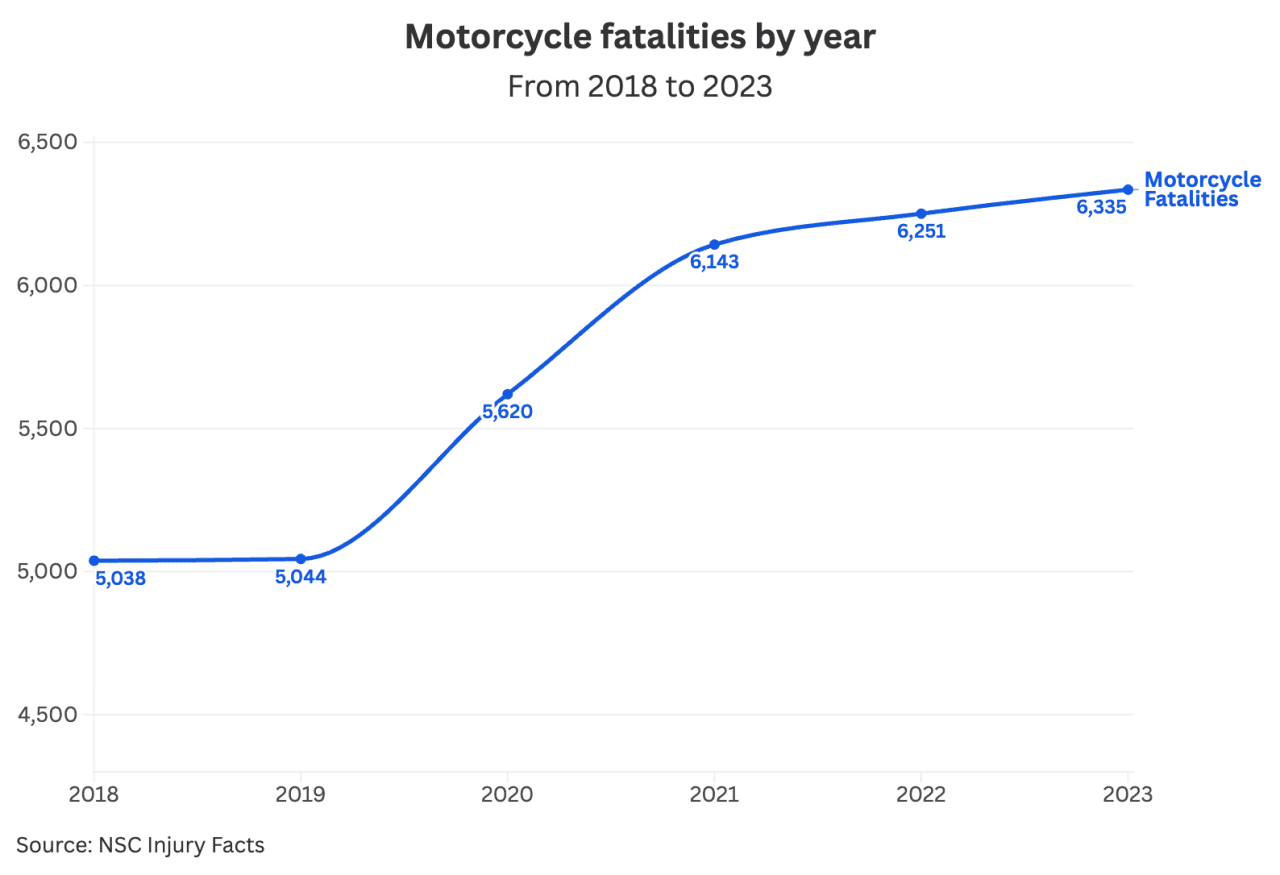Motorcycle crashes account for 15% of fatal crashes on roads. These are the deadliest states.

VDB Photos // Shutterstock
Motorcycle crashes account for 15% of fatal crashes on the roads. These are the deadliest states.
The Insurance Institute for Highway Safety has found that there are approximately 8.8 million motorcyclists on the road in the United States, according to active registrations from each state. This number marks a sharp increase since 2002, which had only 4.3 million motorcyclists.
This growing number is a concern for the National Highway Traffic Safety Administration, as they’ve found that 15% of all traffic fatalities were motorcyclists. To put it in perspective, there are 1.13 passenger car fatalities for every 100 million vehicle miles traveled, compared to the rate for motorcyclists, which is 31.39 fatalities per 100 million miles traveled.
Using data from the IIHS and the Fatality Analysis Reporting System, CheapInsurance.com breaks down the difference in fatality rates by state, the factors that affect these rates, and how deaths can be prevented.
The growing concern of motorcycle fatalities
The National Highway Traffic Safety Administration reported there were 6,335 motorcyclists killed in 2023, an increase from 6,251 in 2022 and a significant jump from fewer than 3,000 in 2000, according to data released in July 2025. The trend is clear. Motorcycle fatalities are on the rise, and legislators, governmental bodies, and the general public are becoming increasingly concerned.
Individuals and organizations are looking for ways to curb this crisis. To do so, one must examine where these fatalities are the most common and what cultural and legal factors are contributing to them.
Motorcycle fatalities by state
The rate of motorcycle fatalities varies widely from state to state. There can be many reasons for these discrepancies; however, helmet use is one of the biggest contributing factors, according to the National Safety Council.
Below, the graph displays the rates of motorcycle fatalities by state. This data is normalized for motorcycle ownership in each state.

CheapInsurance.com
Top 5 most dangerous states based on motorcycle fatalities per 10,000 registered motorcyclists
- Texas – 15.2
- Missouri – 13.9
- Arkansas – 12.3
- Louisiana – 12.1
- Arizona – 11.2
Top 5 safest states based on motorcycle fatalities per 10,000 registered motorcyclists
- Maine – 2.5
- Wisconsin – 3.2
- Minnesota – 3.3
- Alaska – 3.6
- Iowa – 3.6
Motorcycle helmet laws: Historical to present
Universal helmet laws were once in place across the United States. The Centers for Disease Control and Prevention reported that the Highway Safety Act of 1966 required states to implement universal helmet laws in order to receive federal transportation funds. As a result, these laws were in effect in 47 states and the District of Columbia by 1975.
However, federal penalties for not implementing these laws were removed in 1975, and half of these states reduced or removed the requirement. Since then, some states have re-initiated helmet laws for motorcyclists. Today, only 19 states and the District of Columbia require all riders to wear helmets. Others have age restrictions.
How helmet laws affect motorcycle fatalities
According to Eric Teoh, the IIHS director of statistical services, “Wearing a helmet is one of the biggest things riders can do to protect themselves from death and traumatic brain injury.” Data reported from the National Safety Council supports this. Wearing a helmet on a motorcycle is 37% effective at reducing fatalities for the driver and 41% for passengers.
These findings suggest that states with less restrictive helmet laws will have higher rates of motorcycle fatality. However, this does not paint a definitive picture, as other factors are at play.
State roadway infrastructure and its impact on motorcycle fatality
The Federal Highway Administration recognizes that poor road infrastructure can be dangerous for motorcyclists. The FHA uses suggestions and information from the Motorcyclists Advisory Council to make decisions on improving roadway safety. The key issues they focus on include:
- Motorcyclist safety
- Barrier design, road design, construction, and maintenance practices
- Intelligent transportation technologies
Using the advice given by the advisory council, the FHA has taken measures to improve the quality of roadways for motorcyclists. Most of this focus has been on non-interstate major roads, as it has been found that 53% of motorcyclist deaths in 2023 occurred on them, based on data collected from the total number of motorcycle fatalities in the U.S.
Behavioral attitudes affected helmet usage
It’s worth noting that the culture of each state can have an impact on the number of fatalities, particularly the attitude towards helmets.
For example, in a 2024 study in the Injury Epidemiology journal, researchers found that adolescents who lived in more rural farm areas were less likely to wear a helmet while riding an ATV or motorcycle. This study surveyed 1,331 residents, half of whom resided on a farm, 21% in the country but not on a farm, and 28% in a town.
In a 2025 study in the International Journal of Critical Illness and Injury Science, researchers investigated the primary reasons why non-helmeted motorcyclists involved in a crash did not wear protection in India. Alcohol abuse, lower education levels, and travel on municipal roadways all had a statistically significant correlation to non-helmeted motorcycle use. This study was conducted by using data from emergency room visits from March 2021 to December 2021 in Eastern India. In that study, 346 patients were surveyed.
This data could suggest that motorcyclists in states with lower levels of education, higher rates of alcohol abuse, more municipal-maintained roads, and more rural zoning may have higher rates of non-helmeted motorcycle use.
Motorcycle deaths keep rising
Since 2019, motorcyclist fatalities have risen dramatically. The factors for this rise are not immediately clear but can be linked to many of the factors discussed in this article, including lack of helmet use, cultural attitudes, and road infrastructure issues.

CheapInsurance.com
Statistically, most motorcycle deaths happen on urban roads, during clear weather, at night, with a helmet, and not under the influence of alcohol. This data provides a snapshot of U.S. motorcycle fatality trends but does not paint the full picture.
Solutions to combat motorcycle fatalities
Most motorcycle fatalities are completely preventable. Helmet use, obeying speed limits, driving sober, and watching changing weather conditions can all reduce the likelihood of motorcycle accidents and deaths.
In addition to these general suggestions, the NHTSA offers a few crucial pieces of guidance to both motorcycle riders and vehicle drivers:
- Awareness: Vehicle drivers should increase their awareness of motorcyclists on the road and the unique challenges they face, such as their limited visibility. Drivers should also learn how to react to common motorcycle driving techniques, such as weaving.
- Road readiness: Motorcyclists should be proactive. Before every ride, they should check tire tread depth and wear, hand and foot brake functionality, and signal light functionality.
- Riding responsibly: Motorcycle riders should always ride with the flow of traffic and leave plenty of room between themselves and other vehicles so that they can remain visible.
The road ahead for motorcycle safety
Recent data shows that motorcyclist fatalities are on the rise and that trend is likely to continue. As more riders take to the roadways every year, the risks associated with this form of transportation will continue to be prevalent.
By examining state-by-state data, it’s apparent that certain places have higher rates of fatalities due to factors that could be attributed to helmet use, roadway quality, and cultural attitudes. While stopping motorcycle deaths is a challenge, it’s up to riders to operate their motorcycles safely, drivers to practice good motorcyclist awareness, and legislative bodies to invest resources into education and traffic safety resources.
This story was produced by CheapInsurance.com and reviewed and distributed by Stacker.
![]()
